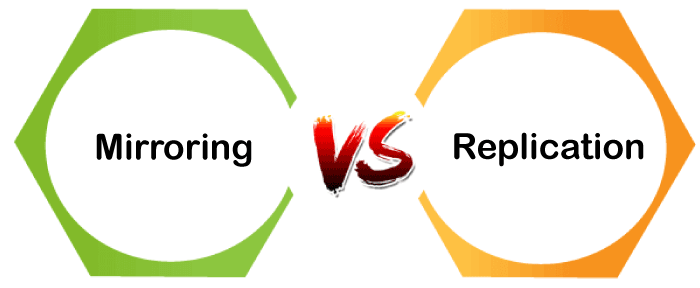Difference between Mirroring and ReplicationMirroring and Replication are two different DBMS techniques that help to increase data availability and reliability. Mirroring includes duplicate copies of a database, whereas replication consists of duplicated data and database objects like views, tables, etc. The primary distinction between these techniques is that the mirroring technique refers to copying a database to different machines. In contrast, replication contains the copy of database objects and data from one database to another. In this article, you will learn about the difference between Mirroring and Replication. But before discussing the differences, you must know about Mirroring and Replication. What is Mirroring?Mirroring is the technique of replicating data and databases. Mirroring is also referred to as "Shadowing". In most cases, mirroring involves copying the database to a completely other system or location from the original database. If any of the primary servers crash during maintenance, the system will automatically fail to the mirrored database. As a result, only one copy can be getting at any given moment. Mirroring is done on the database but doesn't support the distributed database. The tight coupling between the mirrored and primary databases is formed by transmitting transaction log blocks to the mirrored database. It may also restore data in the event of a failure by copying data from one database to another. When a failover occurs, the mirror database becomes the primary database. What is Replication?Replication is the process of creating and distributing duplicate data and database objects across many databases to improve data availability. It can gather corporate information from geographically distributed sites and deliver it to remote users via local area networks or the internet. It speeds up the execution of parallel commands. The Publisher in Microsoft SQL server is an entity that offers data for replication to other servers. The Subscriber is often a server that obtains duplicated data from a publisher. There are mainly three types of Microsoft SQL servers for replication operation. These are as follows:
Snapshot ReplicationSnapshot replication delivers data exactly as it exists at a specific time and doesn't check for data updates. The entire snapshot is generated and transmitted to Subscribers when synchronization occurs. Transactional ReplicationIt usually starts with a snapshot of the publication data and database objects. After the initial snapshot, any extra data updates and schema modifications made by the Publisher are typically provided to the Subscriber as they arise. The Subscriber gets the data modifications in the same sequence and within the same transaction boundaries as the Publisher. Therefore, transactional consistency is assured within a publication. Merge ReplicationThe merge replication is much similar to transactional replication because it also often begins with a snapshot of the objects and data in the publication database. The Publisher and Subscribers do the subsequent data modifications and schema updates, which are all tracked with the triggers. When the user is connected to the network, the Subscriber synchronizes with the Publisher and exchanges all rows that have altered because the last time synchronization took place. Key Differences between Mirroring and Replication
There are various key differences between Mirroring and Replication. Some main key differences between Mirroring and Replication are as follows:
Head-to-head comparison between Mirroring and ReplicationHere, you will learn the head-to-head comparisons between Mirroring and Replication. The main differences between Mirroring and Replication are as follows:
ConclusionThe mirroring and replication techniques help to enhance the data availability, performance, and dependability. Mirroring techniques necessitates multiple copies of a database. In contrast, replication entails replicating data and database objects, including tables, user-defined functions, stored procedures, and materialized views.
Next TopicDifference between
|
 For Videos Join Our Youtube Channel: Join Now
For Videos Join Our Youtube Channel: Join Now
Feedback
- Send your Feedback to [email protected]
Help Others, Please Share










